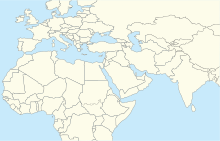A mosque or masjid is a place of prayer for Muslims. Mosques are usually covered buildings, but can be any place where prayers (salah) are performed, including outdoor courtyards.

Medina, officially Al-Madinah al-Munawwarah and also commonly simplified as Madīnah or Madinah, is the capital of Medina Province in the Hejaz region of western Saudi Arabia. One of the most sacred cities in Islam, the population as of 2022 is 1,411,599, making it the fifth-most populous city in the country. Around 58.5% of the population are Saudi citizens and 41.5% are foreigners. Located at the core of the Medina Province in the western reaches of the country, the city is distributed over 589 km2 (227 sq mi), of which 293 km2 (113 sq mi) constitutes the city's urban area, while the rest is occupied by the Hejaz Mountains, empty valleys, agricultural spaces and older dormant volcanoes.

The Prophet's Mosque is the second mosque built by the Islamic prophet Muhammad in Medina, after that of Quba, as well as the second largest mosque and holiest site in Islam, after the Masjid al-Haram in Mecca, in the Saudi region of the Hejaz. The mosque is located at the heart of Medina, and is a major site of pilgrimage that falls under the purview of the Custodian of the Two Holy Mosques.
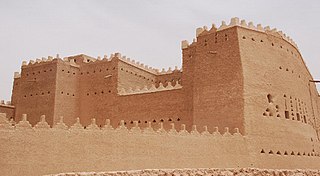
Diriyah, formerly romanized as Dereyeh and Dariyya, is a town and governorate in Saudi Arabia located on the north-western outskirts of the Saudi capital, Riyadh. Diriyah was the original home of the Saudi royal family, and served as the capital of the Emirate of Diriyah under the first Saudi dynasty from 1727 to 1818. Today, the town is the seat of the Diriyah Governorate, which also includes the villages of Uyayna, Jubayla, and Al-Ammariyyah, among others, and is part of Ar Riyad Province.
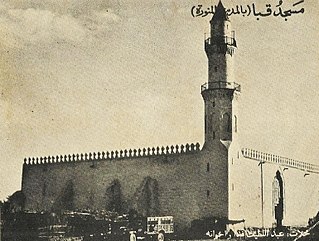
The Quba Mosque is a mosque located in Medina, in the Hejazi region of Saudi Arabia, built in the lifetime of the Islamic prophet Muhammad in the 7th century C.E. It is thought to be the first mosque in the world, built on the first day of Muhammad's emigration to Medina. Its first stone is said to have been laid by the prophet, and the structure completed by his companions.

The Mīqāt Dhu al-Ḥulayfah, also known as Masjid ash-Shajarah or Masjid Dhu al-Hulayfah, is a miqat and mosque in Abyār ʿAlī, Medina, west of Wadi al-'Aqiq, where the final Islamic prophet, Muhammad, entered the state of ihram before performing 'Umrah, after the Treaty of Hudaybiyyah. The mosque is located 7 km (4.3 mi) SW of the Al-Masjid an-Nabawi and was defined by Muhammad as the miqat for those willing to perform the Hajj or Umrah pilgrimages from Medina. It is the second-largest miqat mosque after the Miqat Qarn al-Manazil in As-Sayl al-Kabir.

The Masjid al-Qiblatayn, also spelt Masjid al-Qiblatain, is a mosque in Medina believed by Muslims to be the place where the final Islamic prophet, Muhammad, received the command to change the Qibla from Jerusalem to Mecca. The mosque was built by Sawad ibn Ghanam ibn Ka'ab during the year 2 AH and is one of the few mosques in the world to have contained two mihrabs in different directions.

The Zamzam Well is a well located within the Masjid al-Haram in Mecca, Saudi Arabia. It is located 20 m (66 ft) east of the Kaaba, the holiest place in Islam.

Both Sunni Muslims and Shia Muslims agree on the three Holiest sites in Islam being, respectively, the Masjid al-Haram, in Mecca; the Al-Masjid an-Nabawi, in Medina; and Al-Masjid al-Aqsa, in Jerusalem.
Al-Ji'rana is a village in Makkah Province, in western Saudi Arabia. It is located 18 miles northeast of Mecca.
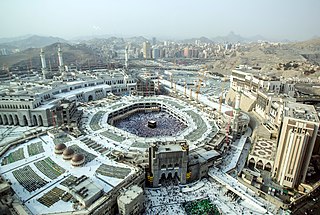
Masjid al-Haram, also known as the Sacred Mosque or the Great Mosque of Mecca, is a mosque enclosing the vicinity of the Kaaba in Mecca, in the Mecca Province of Saudi Arabia. It is among the pilgrimage sites associated with the Hajj, which every Muslim must perform at least once in their lives if able. It is also the main site for the performance of ʿUmrah, the lesser pilgrimage that can be undertaken any time of the year. The rites of both pilgrimages include circumambulating the Kaaba within the mosque. The Great Mosque includes other important significant sites, such as the Black Stone, the Zamzam Well, Maqam Ibrahim, and the hills of Safa and Marwa.
Mosque of Al-Fadeekh, or Asy-Syams Mosque, is a mosque formerly used by the Islamic prophet Muhammad and his Sahabahs for prayer when they were surrounded by their enemies, and later it was named as Mosque of Bani Nadhir. On the other hand, it is said that Ayah that prohibits khamr (alcohol) was descended here, and Muslims then spilled the alcohol here. Considering the importance of this religious event, which is dealing with the obedience to the religious orders, the mosque was later renamed as Al-Fadeekh, which means a drink made by date palms before being cooked.

Mosque of Al-Ghamamah is one of the oldest mosques in Medina, Saudi Arabia, located in the place believed to be where the Islamic prophet Muhammad performed an Eid prayer in the year 631. It is also narrated that Muhammad offered Salat ul-Istasqa when the city of Madina faced a shortage of rain. For a while, this mosque was closed for daily prayers because of its proximity to the Al-Masjid an-Nabawi. However quite recently it has been reopened for the worshipers for praying. Five times prayers are held in this mosque now with an internal sound system to avoid the clash of sounds from the Prophet's Mosque. The mosque is one of the historical relics of Medina.
Fash Mosque, or Masjid Uhud is a small mosque beneath the Mount Uhud, under the cave, in Medina, Saudi Arabia. There are some accounts of the Islamic prophet Muhammad fulfilling the Zuhr prayer on the day of the Battle of Uhud after the battle. The construction is already destroyed and there are only few remnants of the east, west and south wall, and the mehrab mujawwaf which is still visible. The building is now surrounded by an iron fence to guard its sustainability. It is 4.5 km from Al-Masjid an-Nabawi.
Al-Fuqair Mosque or Mutsib Mosque is a mosque located in Medina, Saudi Arabia. It is narrated that the Islamic prophet Muhammad performed a prayer here once. The mosque is located in the right hand side of the main street which connects Qurban and Awali, and it is 1.9km from Quba Mosque, next to a gas station.

The Seven Mosques is a complex of six small historic and often visited mosques in the city of Medina, Saudi Arabia. The complex consists of six mosques in spite of the name "Sab'ah" means "seven", because Saudis demolished one. Although the mosque is often visited by pilgrims, Saudi sources claim that there are no accounts in the order from the Islamic prophet Muhammad or in Sharia regarding the virtue of visiting these mosques. The prophet said: "You do not force yourself for preparation of visiting except these three mosques: Al-Masjid an-Nabawi, Masjid al-Haram, and Al-Aqsa. But recently there is a push towards saving this as cultural and religious heritage. Like referred below for Masjid Ali bin Abu Talib.

Al-Ijabah Mosque, also known as "Bani Muawiyah Mosque" or "Al-Mubahalah Mosque", is a mosque in Medina, Saudi Arabia, which was built during the time of the Islamic prophet Muhammad on a land owned by Muawiyah bin Malik bin 'Auf of the tribe of As-Sus.
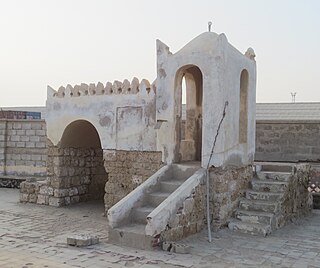
The Mosque of the Companions is a mosque in the city of Massawa, Eritrea. Dating to the early 7th century C.E., it is believed by some to be the first mosque built in Africa.
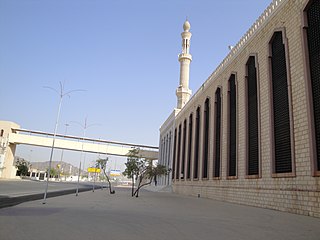
Masjid al-Namirah is a mosque in Wadi Uranah near Mecca in the Makkah Province of Saudi Arabia. It is believed to be where the Islamic prophet Muhammad stayed before delivering his last sermon in Arafat. It is one of the most important landmarks during the Hajj, as it is where the khutbas are delivered to pilgrims during the Day of Arafah during the Dhuhr and Asr prayers. It is located near the Mount Arafat.

Al-Qantara Mosque, also known as Al-Madhoun Mosque or Qabil Mosque is a now abandoned 19th century Ottoman-era historical mosque in the al-Mathnah neighborhood of Ta’if, Saudi Arabia. Built during the time of Sharif Abd al-Muttalib ibn Ghalib, the mosque is believed to be constructed upon one of the sites where Prophet Muhammad and Zayd ibn Harithah took rest in an orchard while on their way back to Mecca in the aftermath of their expulsion by the leaders and residents of Ta’if in around 620 during the Year of Sorrow.


